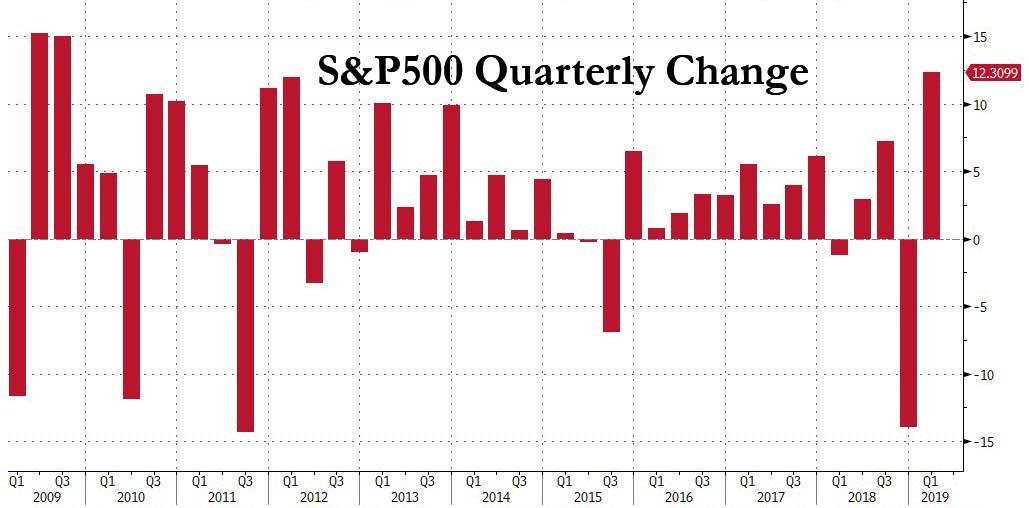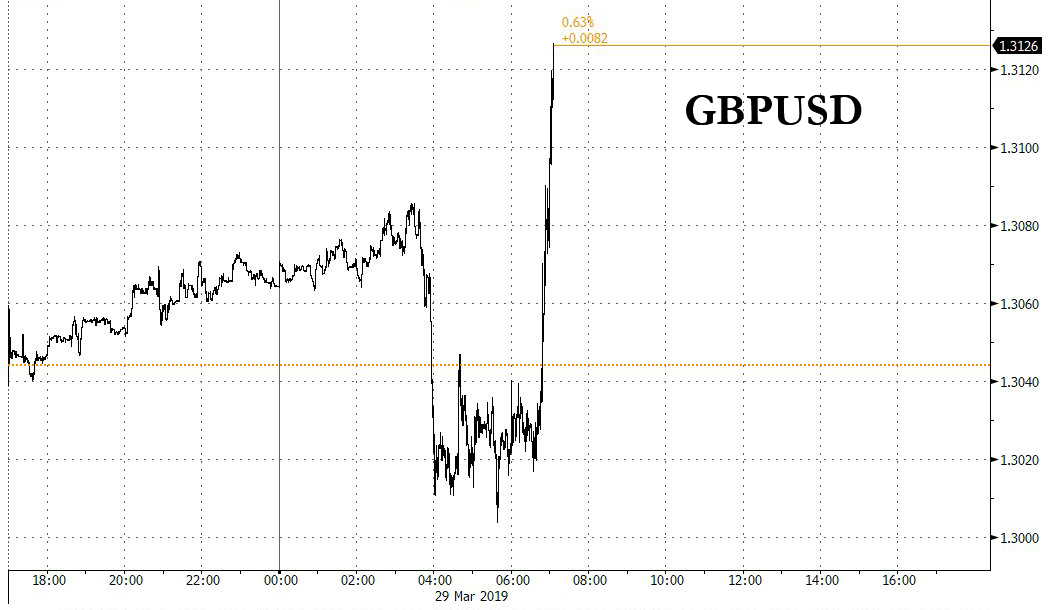 “What if I told you there was a paper on climate change that was so uniquely catastrophic, so perspective-altering, and so absolutely depressing that it’s sent people to support groups and encouraged them to quit their jobs and move to the countryside?” asks reporter Zing Tsjeng over at Vice. She is citing Professor of Sustainability Leadership at Cumbria University Jem Bendell’s “Deep Adaptation” paper that asserts that man-made climate change will result in “a near-term collapse in society with serious ramifications for the lives of readers.” How near-term? In about 10 years or so.
“What if I told you there was a paper on climate change that was so uniquely catastrophic, so perspective-altering, and so absolutely depressing that it’s sent people to support groups and encouraged them to quit their jobs and move to the countryside?” asks reporter Zing Tsjeng over at Vice. She is citing Professor of Sustainability Leadership at Cumbria University Jem Bendell’s “Deep Adaptation” paper that asserts that man-made climate change will result in “a near-term collapse in society with serious ramifications for the lives of readers.” How near-term? In about 10 years or so.
Bendell says that he came to his dire prediction while on a recent unpaid sabbatical during which he “reviewed the scientific literature from the past few years.” He asserts that “the summary of science is the core of the paper as everything then flows from the conclusion of that analysis.” As a consequence, he claims to have discerned from his reading of recent climate science the initiation of drastic non-linear effects that are quickly leading to “runaway climate change.” Therefore, his review forced him to “establish the premise that it is time we consider the implications of it being too late to avert a global environmental catastrophe in the lifetimes of people alive today.” Bendell seems now to be grappling with a kind of spiritual crisis as a result of his melancholy study.
How catastrophic? “When I say starvation, destruction, migration, disease and war, I mean in your own life,” he writes. “With the power down, soon you wouldn’t have water coming out of your tap. You will depend on your neighbours for food and some warmth. You will become malnourished. You won’t know whether to stay or go. You will fear being violently killed before starving to death.”
Bendell decries “professional environmentalists [for] their denial that our societies will collapse in the near-term” and invites readers “to consider the value of leaving mainstream views behind.” But is Bendell’s reading of the recent climate science accurate? My own review of the literature suggests that he has essentially constructed a “parade of horribles” argument that falls apart under a more dispassionate analysis. Bendell anticipates that some critics will reject his grim conclusions by resorting to what he calls unwarranted and psychologically protective “collapse-denial.”
While trying to avoid the “collapse-denial” pitfall, a review of the most recent scientific literature suggests that while climate change will pose significant problems for humanity over the remainder of this century, near-term societal collapse due to runaway climate change is unlikely.
Bendell does report the relatively uncontroversial data that average global surface temperatures have increased by 0.9°C since 1880 and that 17 of the 18 warmest years in that record have all occurred since 2001. The State of the Climate in 2017 report issued last year by the American Meteorological Society cites weather balloon and satellite datasets indicating that, since 1979, the increase of global average temperature in the lower troposphere is proceeding at the rate of between 0.13°C and 0.19°C per decade. According to NASA’s Earth Observatory, the rate of temperature increase since 1975 as measured by thermometers at the surface is roughly 0.15-0.20°C per decade. The State of the Climate in 2017 report also notes that climate models assessed by Coupled Model Intercomparison Project Phase 5 (CMIP5) projected that the lower troposphere should be warming at the rate of 0.27°C per decade.
Reconciling the discrepancy between the rates of empirical and modeled temperature increase will depend on what equilibrium climate sensitivity (ECS) turns out to be. ECS is conventionally defined as how much warming can be expected to result from a doubling of atmospheric carbon dioxide. There is still considerable debate among climate researchers about the magnitude of this figure.
A 2018 article in Climate Dynamics calculated a relatively low climate sensitivity of range of between 1.1°C and 4.05°C (median 1.87°C). Another 2018 study in the Journal of Geophysical Research: Atmospheres estimated a higher ECS that is likely between 2.4°C and 4.6°C (median 3.3°C). The study noted that its analysis “provides no support for low values of ECS (below 2°C)” suggested by other analyses such as the one in Climate Dynamics. The higher that ECS is, the more likely the models’ rate of increase is right and the worse the effects of climate change are liable to be.
Ice
Bendell is particularly concerned about the rate of warming in the Arctic. He correctly observes that the Arctic is warming at twice the rate of the global average. Between the 1920s and the 1940s, a large warming event occurred in the Arctic. Researchers have concluded that that increase was most likely the result of natural internal atmospheric variability. While early 20th century Arctic warming was comparable to the recent 30-year warming, the temperature levels during the past five years (2014–18) have exceeded all previous records since 1900.
As a result of warming temperatures, the extent of arctic sea ice has been falling since 1980 at the rate of 12.8 percent per decade. Some recent research suggests that Arctic warming is affecting weather patterns in the northern hemisphere such as polar vortex outbreaks in the mid-latitudes.
Bendell chiefly hangs his prognostication of “our near-term extinction” on the “permafrost carbon bomb” hypothesis. The idea is that lots of carbon is trapped in the Arctic permafrost and in subsea methane hydrates, and that warming will produce a feedback loop in which carbon will be exponentially released into the atmosphere. Adding Arctic carbon dioxide to the atmosphere is bad enough, but rising temperatures will purportedly cause the non-linear release of vast amounts of methane which has a global warming potential that is 28 to 36 times greater than carbon dioxide.
In support of this dire scenario, Bendell points to a 2013 report in Nature that conjectured that warming could lead to a burp of 50-gigatons of methane over less than 10 years out of the Arctic Ocean. The result would be an immediate increase of global temperatures by about 5°C at a cost to the global economy of $60 trillion. The size of the global economy was then about $70 trillion. Rather than merely cratering the global economy, such a methane burp might also result in our extinction.
So how worried should we be? Bendell handwaves aside numerous more current scientific reviews and studies that conclude that a permafrost carbon bomb is implausible. One comprehensive 2017 review of sources and sinks of methane reported that “atmospheric measurements at long-term monitoring stations show no significant increase of Arctic methane emissions. This suggests that at present, Arctic emission increases are negligible or small in absolute terms.”
Bendell instead speculates that recent increases in atmospheric methane indicate that a nonlinear Arctic methane catastrophe that could result in “our near-term extinction” is in the offing. As evidence, he cites a recent experiment in which German researchers monitored chunks of melting permafrost for seven years and found that they did emit more than expected amounts of methane. Based on this experiment, the researchers calculate that “the permafrost soils of Northern Europe, Northern Asia and North America could produce up to 1 gigaton of methane and 37 gigatons of carbon dioxide by 2100.” That’s 1 gigaton of methane over 80 years, not 50 gigatons in 10 years. And as it happens, human activity emitted 37 gigatons of carbon dioxide in 2018, which means that Arctic permafrost thawing would add just a bit over 1 percent to annual carbon dioxide emissions between now and 2100.
In addition, a 2017 Nature Communications study traces the increases in atmospheric levels of methane that Bendell references not to permafrost, but instead to a combination of leaks from fossil fuel production and higher emissions from agriculture and wetlands. A 2019 Scientific Reports modeling study finds that abating man-made methane emissions would “limit methane-caused climate warming by 2100 even in the case of an uncontrolled natural Arctic methane emission feedback.” It appears that “our near-term extinction” from a detonating permafrost carbon bomb is highly unlikely.
Other than the trends in the Arctic region, Bendell asserts that humanity is already seeing the impacts of global warming on storms, drought, and flood frequencies. Climate change is also set to dramatically reduce harvests resulting in global famines. He further asserts that half of the world’s coral reefs have died in the past 30 years and that rising temperature is causing an exponential rise in mosquito and tickborne illnesses.
Weather
Let’s take storms first. In a 2018 study, researchers associated with the Global Precipitation Climatology Project reported that global precipitation increased between 1979 and 2017 by 0.33 percent per decade, for an overall increase of about 1 percent. Interestingly another 2018 study in the Bulletin of the American Meteorological Society (BAMS) reported, “The take-home message from our study using the new 33+ years of high-resolution global precipitation dataset is that there seems not to be any detectable and significant positive trends in the amount of global precipitation due to the now well-established increasing global temperature. While there are regional trends, there is no evidence of increase in precipitation at the global scale in response to the observed global warming.”
While the global trend toward more precipitation is small, meteorologists have found that there has been a significant increase in the frequency of more intense rainstorms. “On a global scale, the observational annual-maximum daily precipitation has increased by an average of 5.73 millimeters (0.23 inch) over the last 110 years, or 8.5 percent in relative terms,” reported a 2015 study.
Tropical cyclones are the most damaging type of storms. Most climate models project that as temperatures rise there will be fewer but bigger hurricanes, typhoons, and cyclones. The MIT climatologist Kerry Emanuel reports a significant global increase since 1980 in all storms with maximum wind speeds above 175 kilometers per hour (109 miles per hour). Storms of 200 km/h (125 mph) and more have doubled in number, and those of 250 km/h (155 mph) and more have tripled. Climatologist Ryan Maue tracks global tropical cyclone activity and he also finds that while the number of cyclones has been declining since 1980, the trend toward bigger storms has been slightly increasing. While cyclones generate dangerous coastal storm surges, the good news is that global mortality from storm surges has been decreasing since the 1960s.
Storm surges from cyclones will likely become more damaging as water from melting glaciers and ice caps on land drains into the oceans and increase average sea level. A 2018 BAMS article notes that sea level rise is accelerating at 0.084 millimeters per year. On top of the current rate of 3 millimeters per year, this implies an average rise of about 20 inches by 2100. Between 1880 and 2015, sea level rose by almost 9 inches.
Using a worst-case climate scenario in which no efforts were made to reduce future warming, a 2018 study in Earth’s Future projected that sea level would rise by 2 and half feet by 2100. The researchers estimated that that increase would globally expand the area of land located in the 1-in-100 year coastal flood plain from its current area of about 210,000 square miles, to 290,000 square miles in 2100. The percent of the global population threatened by coastal flooding would rise (in the worst case scenario) from 3.6 percent now to about 5.4 percent by 2100.
A 2018 study in Global Environmental Change, this one also evaluating the economic effects of projected sea level increases ranging from 1 to 6 feet by 2100, concluded that it would be cost effective to invest in the protection of just 13 percent of the global coastline, thus safeguarding 90 percent of the global coastal floodplain population and 96 percent of assets in the global coastal floodplain. If these projections are approximately correct, addressing sea level rise will be costly, but it does not portend near-term societal collapse.
One might expect that more intense rainstorms should result in more flooding, but a 2017 study investigating maximum streamflow trends around the globe in the Journal of Hydrology found that there were more streamflow measuring “stations with significant decreasing trends than significant increasing trends across all the datasets analysed, indicating that limited evidence exists for the hypothesis that flood hazard is increasing.”
Another 2018 study in Water Resource Research reported that “flood magnitudes are decreasing despite widespread claims by the climate community that if precipitation extremes increase, floods must also.” The explanations for declining flood magnitudes include the possibility that soils now tend to be drier and so absorb more water, and that intense rainstorms–while more frequent–are geographically smaller, thus inundating less area. On the other hand, the Dartmouth Flood Observatory reports that the annual number of large floods increased from about 50 in the mid-1980s to around 200 in the early 2000s, and have fallen a bit since.
The opposite of flooding is drought. Is man-made global warming having an effect on the global prevalence of drought? A 2012 study in Nature concluded that “there has been little change in drought over the past 60 years.” A 2014 study in Nature Climate Change, however, suggested that “increased heating from global warming may not cause droughts but it is expected that when droughts occur they are likely to set in quicker and be more intense.” A 2015 study in Earth and Space Science found that the percent of global land area subject to drought has not changed since 1901, even though global evaporation rates and temperatures have increased. The authors suggest that increased precipitation may have counteracted a global trend toward more drought.
Whatever the trend in floods, droughts, and storms, the fact is that the global death rate due to natural disasters has fallen steeply over the past century, from about 24 per 100,000 annually in the 1920s to below 1 per year in the 2010s. This is remarkable considering that world population has quadrupled over that period, and it obviously cuts against Bendell’s dismal prognostications that humanity will be unable to successfully adapt to climate change.
Famine
Bendell asserts that “we are already in the midst of dramatic changes that will impact massively and negatively on agriculture within the next twenty years.” These impacts are supposedly already inducing the “sense of near-term disruption to our ability to feed ourselves and our families.” When contemplating Bendell’s prophecies of imminent agricultural collapse, everyone should keep in mind that cereal and livestock production have both nearly quadrupled since 1961 even as average global temperatures have risen.
In support of his claims that global famine triggered by climate change looms, Bendell references a couple of modeling studies that condescendingly suggest that farmers will essentially do nothing to adapt to climate change. But that’s not correct. For example, farmers in the U.S. and Canada are now taking advantage of the fact that the cornbelt is shifting northward due to warming temperatures.
Oddly, as evidence of impending famine, Bendell cites a 2015 Environmental Research Letter socioeconomic modeling study that actually finds that without climate change grain yields in 2050 would be between 65 and 55 percent higher than they were in 2005. With climate change, depending on the scenario, yields would be only be 45 to 60 percent greater. This is well within a 2017 BioScience study’s projection of a global food demand increase by 2050 that ranges between 25 to 70 percent above current global production.
In any case, many researchers find that agriculture can continue to produce more food while simultaneously adapting to future climate change. For example, a 2017 policy report for the European Commission found that “the impact of climate change on agricultural production in 2050 is negative but relatively small at the aggregated global level.” Remarkably, that study reported that efforts to mitigate greenhouse gas emissions from the agricultural sector by, for example, increasing the prices of fuel and fertilizer, would have a bigger negative impact on agricultural production than would climate change.
Oceans
Coral reefs occupy less than one quarter of one percent of our oceans, but they’re home to an estimated 25 percent of all marine species. Bendell correctly observes that coral bleaching due to rising average temperatures in the tropical oceans is increasing. When water temperatures get too hot, corals expel their symbiotic algae and that deprives them of nourishment. The BAMS State of the Climate 2017 report noted that mass coral bleaching has historically occurred when ocean temperatures rose during El Niño events in 1983, 1998, and 2010. However, an unprecedented 36-month ocean heatwave in 2014 to 2017 affected 75 percent of Earth’s tropical reefs, and at nearly 30 percent of reefs, it reached mortality level. Mass bleaching used to occur once every 25–30 years in the 1980s, but now mass bleaching returns about every six years and is expected to further accelerate.
Clearly reefs are suffering from the heat, but some recent research hints that they are adapting to cope with rising temperatures. A 2019 global analysis of coral bleaching over the past two decades in Nature Communications reports that “in the last decade, the onset of coral bleaching has occurred at significantly higher sea surface temperatures (∼0.5 °C) than in the previous decade.” The researchers suggest that individuals of various coral species that are especially liable to bleach when temperatures warm “may have declined and/or adapted such that the remaining coral populations now have a higher thermal threshold for bleaching.” In other words, corals appear to be evolving to withstand higher temperatures.
Disease
“In some regions we are witnessing an exponential rise in the spread of mosquito and tick-borne viruses as temperatures become more conducive to them,” writes Bendell. He cites a 2018 European Commission report evaluating the impact of climate change on the rates of viral disease chiefly spread by mosquitoes. All things being equal, the report notes that the range of two disease carrying mosquito species—Aedes aegypti and Aedes albopictus—are likely to expand as the global temperatures rise. These two especially vexatious species transmit Zika, dengue, and Chikungunya viruses. Climate change will eventually enable these species to expand their ranges, concurred a 2019 modeling study in Nature Microbiology, but “in the next 5 to 15 years, the models predict that spread of both species will be driven by human movement, rather than environmental changes.”
While certainly burdensome, the mortality rates for Zika, dengue, and chikungunya are low. So even implausibly assuming that no progress at all is made in controlling these pests and the diseases they transmit, their spread does not threaten near-term human extinction.
Fortunately, progress is being made on vaccines for each of these (and many other) vector-borne illnesses. In addition, biotechnologists are developing techniques that can either prevent mosquitoes from carrying pathogens or eliminate the pests from the landscape altogether. Similar biotech interventions are being developed to control diseases spread by other vectors as well. As a result, the role of climate change will decreasingly figure as a factor in determining human exposure to vector-borne illnesses.
Apocalypse
Bendell acknowledges that some researchers have suggested developing geoengineering as an emergency backup plan for cooling down the planet in case global warming runs faster than current projections suggest. But he dismisses it as a potential way to ameliorate climate change because he thinks that its unpredictability will prevent its deployment. This objection will not hold if most people think that rapidly rising temperatures is about to cause global social collapse. As it happens, a 2019 Nature Climate Change study, “Halving warming with idealized solar geoengineering moderates key climate hazards,” by Harvard engineer Peter Irvine and colleagues, finds that spreading sulfur dioxide into the stratosphere to reduce average temperatures by about half the amount temperatures would increase if atmospheric carbon doubled would not likely destabilize current weather patterns.
“It would not be unusual to feel a bit affronted, disturbed, or saddened by the information and arguments I have just shared,” observes Bendell in his discussion of “systems of denial.” Such climate collapse denialism, he argues, is rooted in mixture of wishful thinking, paternalistic efforts to protect the public from despairing, and the refusal to accept our powerlessness to stop climate doom. Collapse denialism is further buttressed by the norms of scientific understatement, the natural psychological resistance to thinking about death, and the institutional positive problem-solving emphases of non-profit, private, and governmental organizations.
Bendell suggests that many people accept much of the data about climate change that he reports, but choose to interpret them in a way that makes them ‘safer’ to their personal psychologies. This, he asserts, amounts to a form of “interpretative denial.” On the other hand, Bendell admits he has “chosen to interpret the information as indicating inevitable collapse, probable catastrophe and possible extinction.” Thus it would seem that his predictions of imminent civilizational collapse are the consequence of a form of “interpretative confirmation.”
Recall that Bendell asserts that “the summary of science is the core of the paper as everything then flows from the conclusion of that analysis.” If his reading of current climate science is faulty or biased, then, so too, are his arguments. My reading of the recent scientific literature finds that while man-made climate change is a significant and growing problem, it does not portend, as argued by Bendell, imminent massive social collapse and the possibility of near-term human extinction.
That being the case, I must conclude, that as well-meaning as he may be, Bendell is engaging in “apocalypse abuse.” Like earlier practitioners of that suspect craft, Bendell operates chiefly by extrapolating only the most horrendous trends, while systematically ignoring any ameliorating or optimistic ones, offering worst-case scenarios in the guise of balanced presentations.
Bendell writes that the impending end of the world has caused him to reevaluate his work choices. He muses that “in order to let oneself evolve in response to the climate tragedy one may have to quit a job—and even a career.” Way back in 1971, overpopulation doomster Paul Ehrlich similarly told Look magazine, “When you reach a point where you realize further efforts will be futile, you may as well look after yourself and your friends and enjoy what little time you have left. That point for me is 1972.” Forty-eight years later, Ehrlich is still predicting an imminent ecological apocalypse and I suspect that Bendell will be doing the same thing in the year 2065.
In his paper Bendell does lamely observe, “We do not know if the power of human ingenuity will help sufficiently to change the environmental trajectory we are on.” Maybe not, but it’s a far better bet than is his concocted case for collapse fatalism.
from Hit & Run https://ift.tt/2FAQpKQ
via IFTTT





 In Washington, D.C. in 2054, a Department of PreCrime determines who is going to commit a crime before it happens. The government uses three mutants, known as “precogs,” who have precise visions of future events. Police are sent in advance to arrest the not-quite-criminals and, voila, the crime rate drops to zero. That is the backdrop of the movie,
In Washington, D.C. in 2054, a Department of PreCrime determines who is going to commit a crime before it happens. The government uses three mutants, known as “precogs,” who have precise visions of future events. Police are sent in advance to arrest the not-quite-criminals and, voila, the crime rate drops to zero. That is the backdrop of the movie,  Those of moderately advanced years may remember what a thrill it was, back in 1993, to encounter The X-Files for the first time. To see a primetime TV show rooted in semi-disreputable genres—sci-fi and horror—that took them seriously enough to bring real money and craft to bear on their revival. Everything about The X-Files, from its woodsy noir atmosphere and baroque conspiracy plot to its eerie earworm synth theme, announced that something new—or at least a cool new take on something old—was suddenly at hand. That feeling didn’t last for all nine years of the show’s original run—good writing is famously hard to sustain—but the early seasons stuck in your head, writes Kurt Loder.
Those of moderately advanced years may remember what a thrill it was, back in 1993, to encounter The X-Files for the first time. To see a primetime TV show rooted in semi-disreputable genres—sci-fi and horror—that took them seriously enough to bring real money and craft to bear on their revival. Everything about The X-Files, from its woodsy noir atmosphere and baroque conspiracy plot to its eerie earworm synth theme, announced that something new—or at least a cool new take on something old—was suddenly at hand. That feeling didn’t last for all nine years of the show’s original run—good writing is famously hard to sustain—but the early seasons stuck in your head, writes Kurt Loder.

 Two teachers at a Head Start program run by Southern Illinois University-Edwardsville (SIUE) have been placed on leave and could face charges after police said they forced students to
Two teachers at a Head Start program run by Southern Illinois University-Edwardsville (SIUE) have been placed on leave and could face charges after police said they forced students to